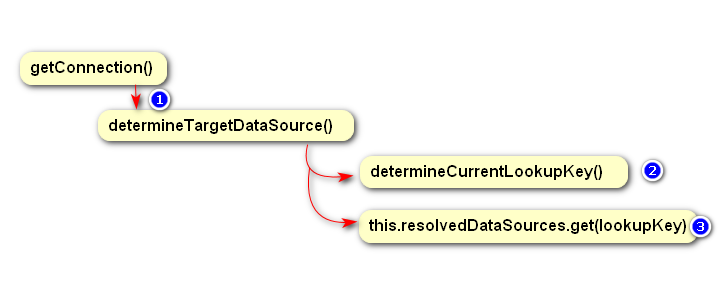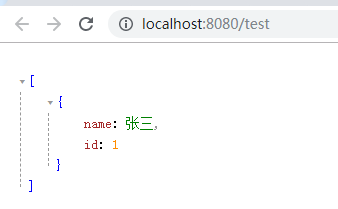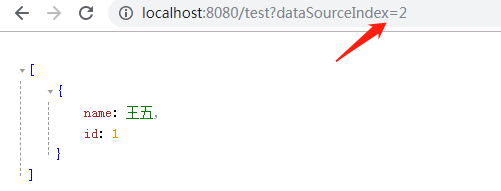原理



接口 DataSource 向外提供一个 getConnection() 方法,用来获取数据库连接,AbstractRoutingDataSource 实现了 getConnection() 方法
1 | // line 166 |
2 | |
3 | public Connection getConnection() throws SQLException { |
4 | return determineTargetDataSource().getConnection(); |
5 | } |
6 | |
7 | ... 省略若干代码 |
8 | |
9 | // line 190 |
10 | /** |
11 | * Retrieve the current target DataSource. Determines the |
12 | * {@link #determineCurrentLookupKey() current lookup key}, performs |
13 | * a lookup in the {@link #setTargetDataSources targetDataSources} map, |
14 | * falls back to the specified |
15 | * {@link #setDefaultTargetDataSource default target DataSource} if necessary. |
16 | * @see #determineCurrentLookupKey() |
17 | */ |
18 | protected DataSource determineTargetDataSource() { |
19 | Assert.notNull(this.resolvedDataSources, "DataSource router not initialized"); |
20 | Object lookupKey = determineCurrentLookupKey(); |
21 | DataSource dataSource = this.resolvedDataSources.get(lookupKey); |
22 | if (dataSource == null && (this.lenientFallback || lookupKey == null)) { |
23 | dataSource = this.resolvedDefaultDataSource; |
24 | } |
25 | if (dataSource == null) { |
26 | throw new IllegalStateException("Cannot determine target DataSource for lookup key [" + lookupKey + "]"); |
27 | } |
28 | return dataSource; |
29 | } |
30 | |
31 | /** |
32 | * Determine the current lookup key. This will typically be |
33 | * implemented to check a thread-bound transaction context. |
34 | * <p>Allows for arbitrary keys. The returned key needs |
35 | * to match the stored lookup key type, as resolved by the |
36 | * {@link #resolveSpecifiedLookupKey} method. |
37 | */ |
38 | |
39 | protected abstract Object determineCurrentLookupKey(); |
然而 ….
AbstractRoutingDataSource 的getConnection() 方法只是调用了 determinTargetDataSource().getConnection() 来获取真正DataSource的getConnection()。

这是典型的装饰模式!!自己没有的功能通过引入其他类来增强。
我们先来看看 AbstractRoutingDataSource 的类结构

被框框套住的都是重要的。
方法determineCurrentLookupKey() 是留给我们开发者的(就像你家的网线口),我们通过实现该方法在不同数据源之间切换。
实践
1. 配置多数据源
在 application.yml 如下配置
1 | spring: |
2 | datasource: |
3 | # 数据源类型 |
4 | type: com.alibaba.druid.pool.DruidDataSource |
5 | # 默认数据源 |
6 | default-datasource: |
7 | driver-class-name: com.mysql.cj.jdbc.Driver |
8 | url: jdbc:mysql://localhost:3306/db0?useUnicode=true&characterEncoding=utf8&zeroDateTimeBehavior=convertToNull&useSSL=true&allowMultiQueries=true&serverTimezone=GMT%2B8 |
9 | username: root |
10 | password: 123456 |
11 | |
12 | # 多数据源 |
13 | target-datasources: |
14 | datasource1: |
15 | driver-class-name: com.mysql.cj.jdbc.Driver |
16 | url: jdbc:mysql://localhost:3306/db1?useUnicode=true&characterEncoding=utf8&zeroDateTimeBehavior=convertToNull&useSSL=true&allowMultiQueries=true&serverTimezone=GMT%2B8 |
17 | username: root |
18 | password: 123456 |
19 | |
20 | datasource2: |
21 | driver-class-name: com.mysql.cj.jdbc.Driver |
22 | url: jdbc:mysql://localhost:3306/db2?useUnicode=true&characterEncoding=utf8&zeroDateTimeBehavior=convertToNull&useSSL=true&allowMultiQueries=true&serverTimezone=GMT%2B8 |
23 | username: root |
24 | password: 123456 |
25 | |
26 | # druid 默认配置 |
27 | druid: |
28 | # 初始连接数 |
29 | initial-size: 10 |
30 | # 最大连接池数量 |
31 | max-active: 100 |
32 | # 最小连接池数量 |
33 | min-idle: 10 |
34 | # 配置获取连接等待超时的时间 |
35 | max-wait: 60000 |
36 | # 打开PSCache,并且指定每个连接上PSCache的大小 |
37 | pool-prepared-statements: true |
38 | max-pool-prepared-statement-per-connection-size: 20 |
39 | # 配置间隔多久才进行一次检测,检测需要关闭的空闲连接,单位是毫秒 |
40 | timeBetweenEvictionRunsMillis: 60000 |
41 | # 配置一个连接在池中最小生存的时间,单位是毫秒 |
42 | min-evictable-idle-time-millis: 300000 |
43 | validation-query: SELECT 1 FROM DUAL |
44 | test-while-idle: true |
45 | test-on-borrow: false |
46 | test-on-return: false |
47 | stat-view-servlet: |
48 | enabled: true |
49 | url-pattern: /monitor/druid/* |
50 | filter: |
51 | stat: |
52 | log-slow-sql: true |
53 | slow-sql-millis: 1000 |
54 | merge-sql: false |
55 | wall: |
56 | config: |
57 | multi-statement-allow: true |
58 | |
59 | # MyBatis |
60 | mybatis: |
61 | # 搜索指定包别名 |
62 | typeAliasesPackage: com.liuchuanv |
63 | # 配置mapper的扫描,找到所有的mapper.xml映射文件 |
64 | mapperLocations: classpath*:mapper/**/*Mapper.xml |
65 | # 加载全局的配置文件 |
66 | configLocation: classpath:mybatis-config.xml |
此处配置的名称(如 defaultDataSource、targetDataSources)的命名并无特殊要求,只要和下面第n步的 DataSourceConfig 中对应起来就可以
使用 Druid 数据源的话,要在 pom.xml 中引入依赖
1 | <!--阿里数据库连接池 --> |
2 | <dependency> |
3 | <groupId>com.alibaba</groupId> |
4 | <artifactId>druid-spring-boot-starter</artifactId> |
5 | <version>1.1.10</version> |
6 | </dependency> |
2. 实现动态数据源
DynamicDataSource 动态数据源,在多个数据源之间切换
1 | public class DynamicDataSource extends AbstractRoutingDataSource { |
2 | |
3 | public DynamicDataSource(DataSource defaultTargetDataSource, Map<Object, Object> targetDataSources) { |
4 | super.setDefaultTargetDataSource(defaultTargetDataSource); |
5 | super.setTargetDataSources(targetDataSources); |
6 | super.afterPropertiesSet(); |
7 | } |
8 | |
9 | |
10 | protected Object determineCurrentLookupKey() { |
11 | return DataSourceContextHolder.getDataSourceType(); |
12 | } |
13 | } |
DataSourceContextHolder 数据源上下文,使用线程变量来存储代表当前使用的数据源的key值(每个key值都对应一个数据源,用以区分多数据源)
1 | public class DataSourceContextHolder { |
2 | |
3 | public static final ThreadLocal<String> CONTEXT_HOLDER = new ThreadLocal<String>(); |
4 | |
5 | public static void setDataSourceType(String dsType) { |
6 | CONTEXT_HOLDER.set(dsType); |
7 | } |
8 | |
9 | public static String getDataSourceType() { |
10 | return CONTEXT_HOLDER.get(); |
11 | } |
12 | |
13 | public static void removeDataSourceType() { |
14 | CONTEXT_HOLDER.remove(); |
15 | } |
16 | |
17 | } |
DataSourceType 数据源对应的key(其实单纯的用字符串来表示数据源,替换枚举类DataSourceType也是可以的,但是写代码时要注意字符串统一)
1 | public enum DataSourceType { |
2 | /** 默认数据源key */ |
3 | DEFAULT_DATASOURCE, |
4 | |
5 | /** 数据源1key*/ |
6 | DATASOURCE1, |
7 | |
8 | /** 数据源2key*/ |
9 | DATASOURCE2; |
10 | } |
3. 将数据源添加到 Spring 容器中
1 | |
2 | public class DataSourceConfig { |
3 | |
4 | |
5 | (prefix = "spring.datasource.default-datasource") |
6 | public DataSource defaultDataSource() { |
7 | return DruidDataSourceBuilder.create().build(); |
8 | } |
9 | |
10 | |
11 | (prefix = "spring.datasource.target-datasources.datasource1") |
12 | public DataSource dataSource1() { |
13 | return DruidDataSourceBuilder.create().build(); |
14 | } |
15 | |
16 | |
17 | (prefix = "spring.datasource.target-datasources.datasource2") |
18 | public DataSource dataSource2() { |
19 | return DruidDataSourceBuilder.create().build(); |
20 | } |
21 | |
22 | |
23 | |
24 | public DataSource dynamicDataSource(DataSource defaultDataSource, DataSource dataSource1, DataSource dataSource2) { |
25 | // 注意:该方法的参数名称要和前面前面三个datasource对象在Spring容器中的bean名称一样 |
26 | // 或者使用 @Qualifier 指定具体的bean |
27 | Map<Object, Object> targetDataSources = new HashMap<>(); |
28 | targetDataSources.put(DataSourceType.DEFAULT_DATASOURCE.name(), defaultDataSource); |
29 | targetDataSources.put(DataSourceType.DATASOURCE1.name(), dataSource1); |
30 | targetDataSources.put(DataSourceType.DATASOURCE2.name(), dataSource2); |
31 | return new DynamicDataSource(defaultDataSource, targetDataSources); |
32 | } |
33 | } |
测试
为了方便,省略了 Service 层
TestController
1 | |
2 | ("/test") |
3 | public class TestController { |
4 | |
5 | |
6 | private TestMapper testMapper; |
7 | |
8 | |
9 | public List<Map<String, Object>> test(String dataSourceIndex) { |
10 | // 根据参数值的不同,切换数据源 |
11 | if ("1".equals(dataSourceIndex)) { |
12 | DataSourceContextHolder.setDataSourceType(DataSourceType.DATASOURCE1.name()); |
13 | } else if ("2".equals(dataSourceIndex)) { |
14 | DataSourceContextHolder.setDataSourceType(DataSourceType.DATASOURCE2.name()); |
15 | } |
16 | List<Map<String, Object>> mapList = testMapper.selectList(); |
17 | // 清除线程内部变量数据源key |
18 | DataSourceContextHolder.removeDataSourceType(); |
19 | return mapList; |
20 | } |
21 | } |
TestMapper
1 | |
2 | public interface TestMapper { |
3 | /** |
4 | * 查询列表 |
5 | * @return |
6 | */ |
7 | List<Map<String, Object>> selectList(); |
8 | } |
TestMapper.xml
1 | |
2 | |
3 | <mapper namespace="com.liuchuanv.dynamicdatasource.mapper.TestMapper"> |
4 | <select id="selectList" resultType="java.util.Map"> |
5 | SELECT * FROM test |
6 | </select> |
7 | </mapper> |
别忘了要准备数据哦!
下面SQL语句,创建3个数据库,然后在3个数据库中都创建一张test表,并各自插入不同的数据。
1 | |
2 | -- 创建数据库 |
3 | create database db0 character set utf8 collate utf8_general_ci; |
4 | create database db1 character set utf8 collate utf8_general_ci; |
5 | create database db2 character set utf8 collate utf8_general_ci; |
6 | |
7 | -- 在数据库db1下执行以下SQL |
8 | use db0; |
9 | create table test( |
10 | id int(11) primary key auto_increment, |
11 | name varchar(20) |
12 | ) ; |
13 | insert into test(name) values('张三'); |
14 | |
15 | |
16 | -- 在数据库db1下执行以下SQL |
17 | use db1; |
18 | create table test( |
19 | id int(11) primary key auto_increment, |
20 | name varchar(20) |
21 | ) ; |
22 | insert into test(name) values('李四'); |
23 | |
24 | -- 在数据库db2下执行以下SQL |
25 | use db2; |
26 | create table test( |
27 | id int(11) primary key auto_increment, |
28 | name varchar(20) |
29 | ) ; |
30 | insert into test(name) values('王五'); |
OK,一切准备就绪,启动应用吧!!!
一启动就出现了各种各样的,似乎无穷无尽的报错!一头黑线。
1. 找不到TestMapper
1 | Field testMapper in com.liuchuanv.dynamicdatasource.controller.TestController required a bean of type 'com.liuchuanv.dynamicdatasource.mapper.TestMapper' that could not be found. |
解决方法:在 DynamicdatasourceApplication 头上添加注解 @MapperScan("com.liuchuanv.*.mapper")
2. dynamicDataSource 依赖循环
1 | ┌─────┐ |
2 | | dynamicDataSource defined in class path resource [com/liuchuanv/dynamicdatasource/common/DataSourceConfig.class] |
3 | ↑ ↓ |
4 | | defaultDataSource defined in class path resource [com/liuchuanv/dynamicdatasource/common/DataSourceConfig.class] |
5 | ↑ ↓ |
6 | | org.springframework.boot.autoconfigure.jdbc.DataSourceInitializerInvoker |
7 | └─────┘ |
解决方法:在 DynamicdatasourceApplication 头上修改注解 @SpringBootApplication(exclude = {DataSourceAutoConfiguration.class})
终于处理好所有的问题,终于能痛痛快快的访问 http://localhost:8080/test

使用的是默认数据源 defaultDataSource

使用的是数据源 dataSource1

使用的是数据源 dataSource2
建议大家在心里总结一下整个的过程,其实很简单

